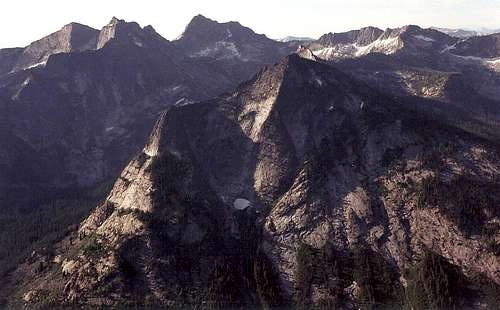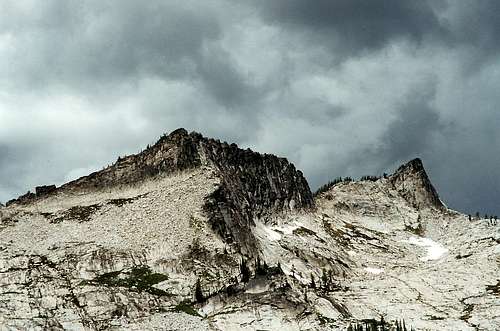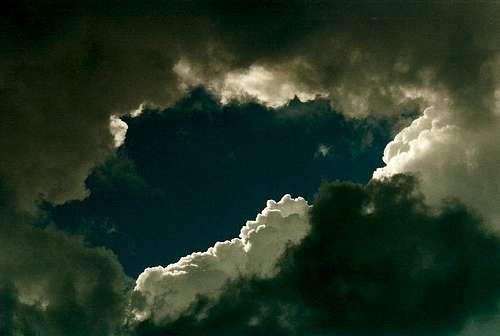Michael Hoyt - Nov 10, 2006 1:23 am - Hasn't voted
We are protectiveBob,
Granted, at first I was a little put off by your characterization of our Bitterroot Mountains, but then I realized you’ve never visited the “real” Bitterroots, only a popular peak and a canyon or two. Trapper Peak and Blodgett Canyon are two of the most-visited spots in our mountains because of, as you said, “easy access.” If you want an alpine experience in the Bitterroots, generally you need to climb above 8,500’ AND make some effort at reaching a truly remote area. Interestingly enough, your later versions of this page verify this reality when you state, “…the finest trail views of the trip…” were near Blodgett Pass
Granted, the Bitterroots are not has “high” as the mountains found in some other ranges, but I doubt anyone who has visited our remote peaks will claim they are less rugged than many others.
As for the dense forest, well I can’t disagree. Fire suppression for most of a century has certainly played a part in that. The fact that the Bitterroots were never mined as heavily as many other places in the country (Colorado 14ers, as one example), thereby keeping the mountains comparatively free of roads, is also an important factor. No roads make it more difficult to log. It’s true everywhere on the planet where trees grow – no roads, thicker forest (until the fires come).
Tim was correct in pointing out that our Bitterroot Mountains were not always an “officially” designated wilderness area and that the dammed lakes were in place long before even the concept of official wilderness was even born. In point of fact, the Bitterroot Valley receives so little rainfall that it almost qualifies as desert. Without the irrigation provided by those dammed lakes it is unlikely the valley would have ever developed the agricultural way of life that formed the basis for habitation by the white man. Now, since the valley’s “discovery”, agriculture is on the wane as gentrification and crowding is infecting our valley, much to the dismay of many who live here.
That being said, there are many more “natural” than “dammed” (damned) lakes hidden in the mountains. You just have to know where to look. The next time you’re in our area, I’ll be happy to take you to Bare Peak, a remote, alpine, and rugged ridge-crest. The route takes you through very little “heavy” forest and passes Nelson Lake which was “naturally” formed by a landslide several centuries ago. I believe you’ll find such an outing offers everything you could wish for. Bare Peak is just one of many examples of alpine wilderness experiences which can be found in the Bitterroots. You just have to know where to look.
Lastly, I feel attaching your trip report to the Bitterroot Mountain Page is slightly inappropriate, in that it would be better if attached to a page for Blodgett Canyon or Blodgett Mountain. Alas, those pages do not currently appear on SP, so that is not your fault. I think your page should stay where it is, but suggest that it be moved if one (or both) of those pages come into existence.
As you’ve probably realized by now, those of us who live near and/or spend considerable time in the Bitterroots are very protective of our mountains. Not so protective, I hope, that we stop considering others’ opinions. But we love our mountains – just the way they are thank you, warts and all!
Mike
Bob Sihler - Nov 10, 2006 1:46 am - Hasn't voted
Re: We are protectiveThanks for all that info, and I might take you up on your offer; it sounds nice. I deleted a lot of what I said since it was an impression based on a small part of a vast area-- it came across as more negative than I meant it to. And it's interesting about the lack of rainfall-- I've run into storms, some very heavy, all four times I've been in the range, and so dampness clouds my impressions, too.
I agree completely about the placement of the page, but I wanted to share the story, and this was the best place to attach. I did look for a Blodgett page, and I even thought of making one for the canyon, but I don't know its full extent well enough, and I think it would be better left to someone closer by, and I hope someone does that.
I did think the Blodgett and Trapper areas were spectacular, though. Personally, I liked Blodgett far more than I like Yosemite Valley, which I think is incredibly overrated and incredibly ruined (but I'd better be careful before the Y. Valley lovers come for me, too).
Anyway, I hope to be back. There's unfinished business for me out there, as I like to say. El Capitan and Blodgett Mountain are among that business, and maybe Bare Peak is now, too.
Bob
T Sharp - Nov 10, 2006 3:40 am - Voted 10/10
Re: We are protectiveDon`t neglect to climb N. Trapper when you come out, and also the Como Peaks traverse. Spectacular country! And oh yeah The Heavenly Twins, Sky Pilot and Ranger Peak too!
Bob Sihler - Nov 10, 2006 4:12 am - Hasn't voted
Re: We are protectivePoint taken, and thanks. What about the Selway Crags? They intrigue me, but I've never been able to learn much about them beyond spotting them on a map and hearing they're awesome.










Comments
Post a Comment